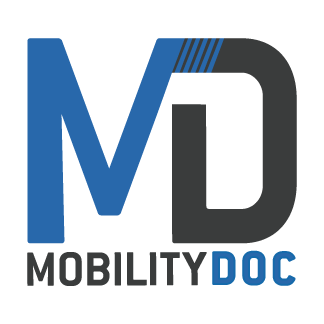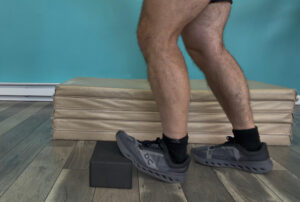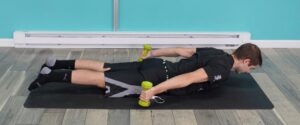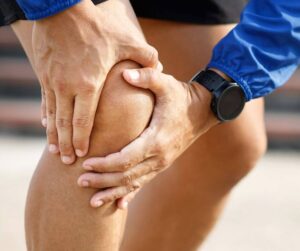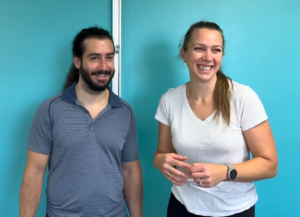The hip hinge is a fundamental movement pattern that’s crucial for maintaining good posture, strength, and flexibility. It’s at the core of many exercises and activities, including squats, running, deadlifts, yoga, and more. One of the most effective ways to build a strong and functional hip hinge is through Romanian Deadlifts (RDLs). In this blog, we’ll dive into why hip hinging is so important, why Romanian deadlifts are excellent for improving this movement, and how to progress through different hip hinge exercises to master the RDL.
Why Is The Ability To Hip Hinge Important?
Hip hinging is the foundation for lower body movement. It’s part of everything you want to do like walking, lifting, skiing, running, yoga, and more. The ability to hip hinge allows you to disassociate your spine from your hips while moving your hips over your femur (thigh bone). We can lose this ability due to tight muscles and decreased strength. When you lose this, what happens is: instead of your spine remaining strong, stable, and independent of your hips while they move, your back comes along for the ride. This results in unnecessary strain and movement in your back often leading to back pain among many other injuries in the lower body.
Why Romanian Deadlifts Are Great for Hip Hinging
Romanian Deadlifts are one of the most effective exercises for improving hip hinge mechanics because that’s exactly what it is! A hip hinge. What’s great about the Romanian deadlift is it has many different variations which range in difficulty from 2 leg variations to 1 leg variations. This allows us to use the same fundamental movement pattern as well as increase the strength and stability of both your hips and spine. This exercise is really easy to incorporate weight into it to help you strengthen and progress as you get stronger.
Romanian Deadlift Progression
To master these hip hinge exercises and improve your form, it’s important to gradually increase the difficulty of your Romanian Deadlifts. The following progression takes you from basic two-legged RDLs all the way to single-leg RDLs, allowing you to develop strength, stability, and control over time.
1. Two-Leg Romanian Deadlift (RDL)
The two-leg Romanian Deadlift is the foundation for the hip hinge. It helps you learn the basic movement pattern without worrying about balancing on one leg. Here’s how to perform it:

- Starting Position: Stand with your feet hip-width apart – we suggest using a dowel or broomstick to make sure you’re keeping your spine secure and stable. The dowel should touch the back of your head, your middle back, and your sacrum (tailbone) and should stay connected the whole time.
- Execution: With a slight bend in the knees keep your hips square as you push your hips back. Keep your spine stable, chest lifted, back neutral, and focus on hinging from the hips rather than bending forward from the waist.
- Goal: You should feel a stretch in your hamstrings. Drive through your hips to return to the standing position making sure you extend fully from your hip flexors
If you want to add some weight into this you can! We suggest holding dumbbells or a barbell. Make sure you keep the weight close to your shins as you hinge from your hips. The two-leg RDL is excellent for building strength in the glutes, hamstrings, and lower back while reinforcing proper hip hinge form. Do 3 sets of 10 until it becomes easy!
2. Asymmetrical Romanian Deadlift

The asymmetrical RDL introduces an element of balance and stability training by performing the exercise with a staggered stance. This variation requires more core engagement and hip stabilization.
- Starting Position: Stand with one foot slightly behind the other. This is important! Make sure you step the foot back and not forward. Stepping the foot forward can mess up your weight distribution.
- Execution: The same principles apply. This time you want to focus on hinging over the front leg while the back leg helps with balance.
- Goal: This variation begins putting focus into more single leg work.
It can be really helpful when starting these out to go from the previous 2 leg RDL to the asymmetrical RDL. Do 3 sets of 10
3. Rear Foot Elevated Romanian Deadlift (RF-E RDL)
Elevating the back foot helps further isolate the front leg and increases the amount of challenge to stabilize.

- Starting Position: Stand in front of a bench or elevated surface, placing one foot on it behind you
- Execution: Keeping your hips square, hinge at the hips while keeping your back straight and your standing leg slightly bent.
- Goal: The rear foot elevated RDL increases stability and strength through each side at a time, allowing you to strengthen the posterior chain and improve flexibility.
4. Single-Leg Romanian Deadlift (Single-Leg RDL)

The single-leg RDL is the final progression and demands the most stability, balance, and control. It’s an excellent way to build strength in each leg individually. We love to go back to using the dowel for this when first starting.
- Starting Position: Stand on one leg with one foot behind you balancing on your toes. Keep a slight bend in the standing leg.
- Execution: Hinge at the hips while extending your free leg behind you for balance. Lower forward keeping your spine neutral and the standing leg engaged.
- Goal: The single-leg RDL targets the hamstrings, glutes, and lower back while improving balance and coordination one leg at a time.
Don’t Make These Hip Hinge Exercise Mistakes!


- Keep your spine stable – don’t round from your shoulders or your back. Make sure you begin with a dowel that is long enough to connect with your head, thoracic spine, and sacrum.
- Don’t bend your knees – this isn’t a lunge. When you hinge down your knees don’t need to bend more.
- Lifting your toes – your weight should be evenly distributed through your feet. Don’t push your weight back so much you’re lifting your toes
- Keep your hips square – often when we add weight or lift the foot it’s common for one of your hips to slide backward or open up. Constantly check that they’re aligned
- Don’t lift up from your back – when adding weight into the exercise when they start standing up it’s common to arch through your back. You won’t fully extend your hips if you do this. Make sure standing up starts from those glutes
- Forward Folding – this isn’t something to practice touching your toes! When your chest hits 90 degrees it shouldn’t go further

How To Progress These Hip Hinge Exercises
As you start getting stronger and feeling better you can begin incorporating different amounts of sets and reps to achieve your goals. Some examples include:
2 sets of 10-15 reps 2 leg RLD’s
1 set of 10-15 reps of asymmetrical RDL’s
1 set of 10-15 reps of rear foot elevated RDL’s
If you want to start working on more single leg stability try:
2 sets of 10-15 reps of asymmetrical RDL’s
2 sets of 10-15 reps of rear foot elevated RDL’s
1 set of 10-15 reps of single leg RDL’s
Remember, form comes first! Don’t rush through these variations just to start incorporating weight. You’ll get more benefits from taking time and doing the exercises properly.
Watch our Hip Hinge Exercise Video on Romanian Deadlifts
Mastering the hip hinge exercises are essential for improving strength, mobility, and overall movement efficiency. Romanian Deadlifts offer an excellent way to improve your hip hinge mechanics Whether you’re coming back from an injury or just looking to move better, incorporating Romanian Deadlift progressions into your routine will help you unlock your full movement potential and reduce the risk of injury.
Unlock Stronger, More Stable Hips in Just 4 Weeks!
Struggling with hip pain, instability, or tightness? Our MDRx Hip 4-Week Hip Strength & Stability Program is designed to help you build a stronger, more stable foundation for all your movements — whether you’re an athlete, a busy professional, or just looking to move better every day.
In just 4 weeks, you’ll:
1️⃣ Strengthen your hip muscles for better support
2️⃣ Improve your range of motion and flexibility
3️⃣ Reduce discomfort and prevent injury
4️⃣ Enhance your performance in daily activities and workouts
Ready to feel the difference? Join now and start your journey to stronger, pain-free hips today. Spots are limited, so don’t wait!
Sign up now and take control of your hip health!
If you’re struggling with back pain check out last week’s strengthening exercises! Hint they feature an RDL!!
